So you’re raising Easter Eggers or thinking about raising Easter Eggers, are you?
Brilliant choice.
How else are you going to amaze your friends and family with the most beautiful, light blue or green eggs?!
Of course, one essential step here is ensuring you’ve actually got an Easter Egger hen and not an Easter Egger rooster!
Whether you’re raising some of your own or are merely curious, here’s everything you need to identify whether you’ve got an Easter Egger rooster or hen, and how you can tell them apart as baby chicks at different ages!
Contents
What Are Easter Egger Chickens?
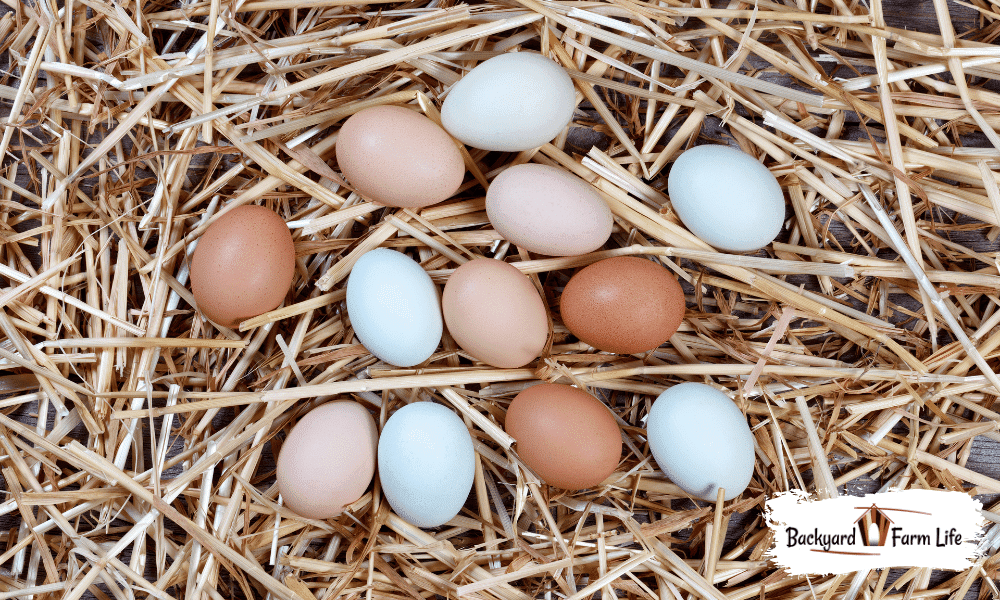
Easter Eggers aren’t actually a specific breed of chicken. Instead, Easter Egger is a general term given to crossbreeds of chickens known to lay blue or green eggs, namely mixes involving the Ameraucana or Araucana chickens.
It’s through these genetic mixes that you can reliably breed chickens that lay these beautiful blue, teal, or green eggs.
You may also find Ameraucana or Araucana chickens being labeled as Easter Eggers, and rightly so as they lay blue and green eggs too!
So Easter Eggers can either refer to Ameraucana or Araucana breeds, or crossbreeds of them!
Other crossbreeds can be made specifically for their egg productivity and temperament, but Easter Eggers are bred for their unique, beautiful eggs!.
Easter Egger Hen Vs. Rooster
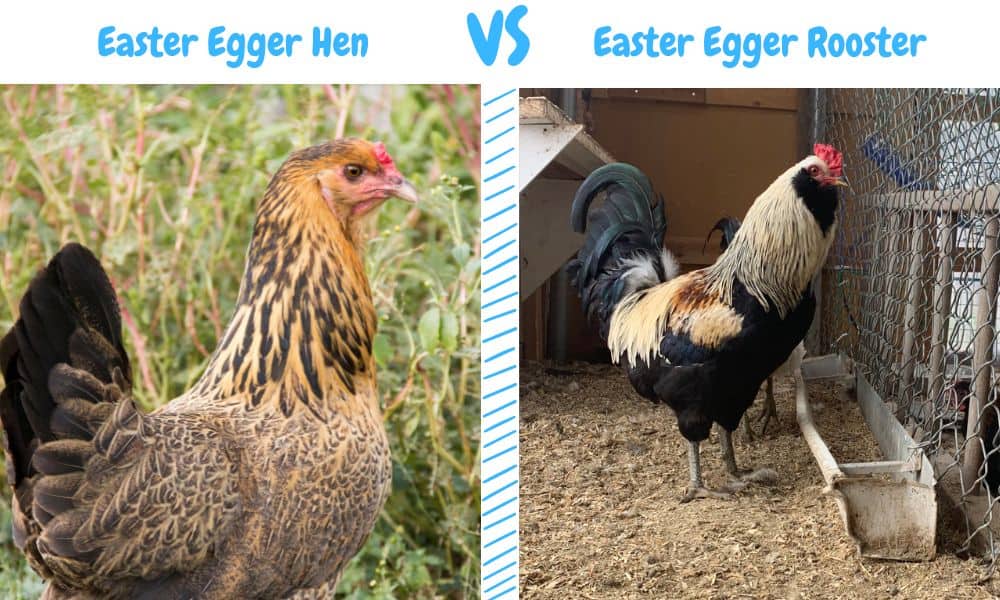
Because most Easter Eggers are bred with Ameraucana or Araucana chickens they usually carry the same physical traits. This helps tonnes when it comes to identifying an Easter Egger rooster from a hen.
Although one half is usually made with Ameraucanas or Araucanas, the other breed they are crossed with can vary significantly.
It’s because of this, that the most reliable way to tell the difference between an Easter Egger rooster and an Easter Egger hen is to look at the common characteristics. That is their overall size, the size and presence of their wattles and combs, and their behavior.
All of these factors can be used to determine if you’ve got an Easter Egger rooster or an Easter Egger hen.
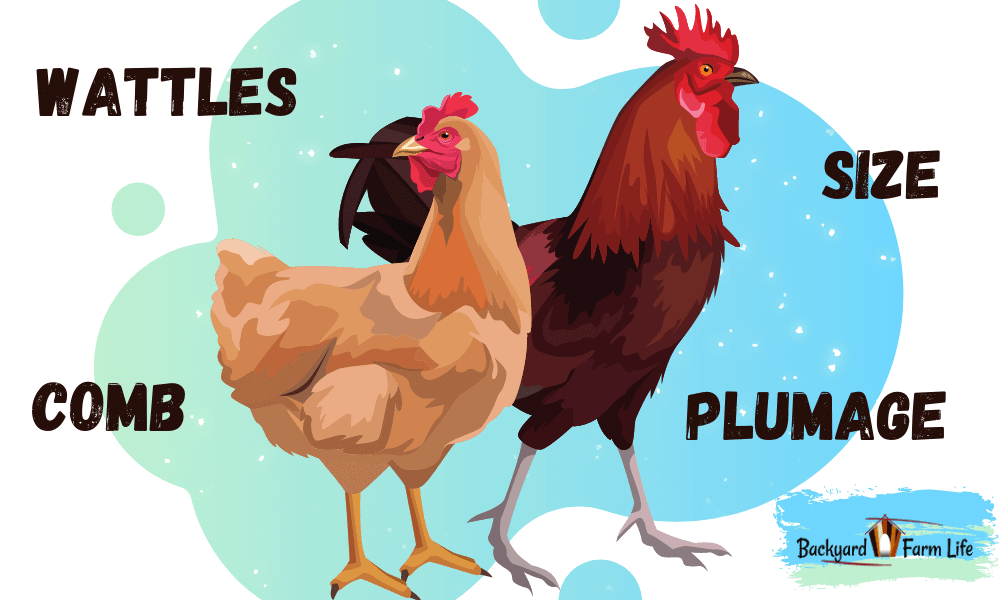
Size
Size is a telltale giveaway between an Easter Egger hen and a rooster, even from an early age.
Both Easter Egger hens and roosters are considered to be a medium size chickens. But, the rooster’s will appears larger than the hens from about 10-16 weeks old, as they near the end of their maturity.
When fully grown, Easter Egger roosters end at around 5-6 pounds and the hens remain at about 4 pounds. Easter Egger roosters usually grow to be as tall as 18-20 inches, and hens will reach up to 16-18 inches.
Wattles & Combs
The wattles & combs of a rooster are almost always larger and more prominent than that of the hens. This goes for Wyandotte roosters vs. hens, ISA Brown roosters vs. hens, and even Silkie roosters vs. hens.
This is also the case for Easter Eggers!
The easiest way to tell an Easter Egger rooster from a hen is by comparing the sheer size of their wattles (much longer), and their combs (much more grand and prominent).
What’s more, is that Easter Egger roosters start growing their combs and wattles from as young as 6-12 weeks. On the other hand, Easter egger hens can take up to 26-20 weeks and their combs and wattles are much smaller.
Color & Plumage
Easter Egger roosters and hens’ beaks range from pale yellow to dark brown, while their legs are yellow to slate in hue. If they’ve been bred with an Araucana or Ameraucana chicken they will have a big pouffy beard, giving them that famous look.
Easter Eggers can come in a variety of colors too, including black, blue, golden brown, and more. It all depends on what it was crossbred with!
So, it’s not exactly obvious when you’re trying to tell the difference between an Easter Egger rooster or hen based on color or plumage.
But, although this isn’t in every case, Easter Egger roosters’ hackle feathers (on their neck) are typically different colors than their body. Easter Egger hens are more likely to be all of one color.
Easter Egger Temperament & Behavior
The majority of Easter Egger chickens are friendly, but there are some reports of them being a bit more reserved and shy compared to other breeds.
Easter Egger hens have a peaceful and gentle temperament, perfect for those with children.
Easter Egger roosters can display hostility or become territorial, but that’s relatively normal for a rooster.
You’ll also find Easter Egger roosters will try and crow from as young as 14-20 weeks.
Easter Egger hens will begin to lay from as old as 20-25 weeks (typically a bit later than other breeds)
As simple as it sounds, these two key behaviors can be used to identify between the roosters and hens too!
Easter Egger Roosters
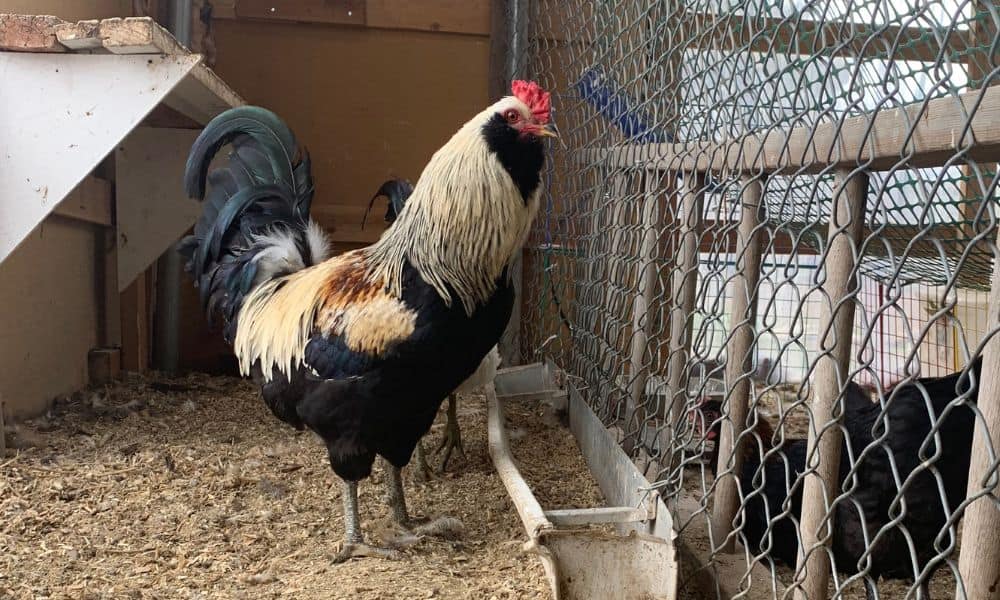
Although it’s fairly obvious that most chicken owners would prefer to raise Easter Egger hens so they can collect beautiful blue or green eggs, raising Easter Egger roosters comes with its very own quirks too.
Not only are Easter Egger roosters incredibly handsome, flaunting their beautiful fluffy beards and muffs, but they make for great flock leaders too!
Easter egger roosters grow to a decent size and are naturally territorial but are not known to be overly aggressive.
We love Easter egger roosters, so don’t be too disappointed if you find out you’re raising one when you expected it to be a hen (it happens!)
Easter Egger Baby Chick: Male Or Female
In some breeds of chickens, it can be difficult to determine whether you’ve got male or female baby chicks. Some even have easier-to-spot differences at younger ages, like polish baby chicks.
When it comes to determining whether you’ve got male or female Easter Egger baby chicks, there are a few things you can look out for as they grow older that tell them apart – or at least hint at it!
You can look for the appearance of wattles and combs, their plumage, the general size of your chickens, and of course, their behaviors.
Generally, as your chicks grow older you’ll be able to piece together all of the evidence and make a good prediction well before their maturity.
Easter Egger 4 Weeks Old Male Vs. Female
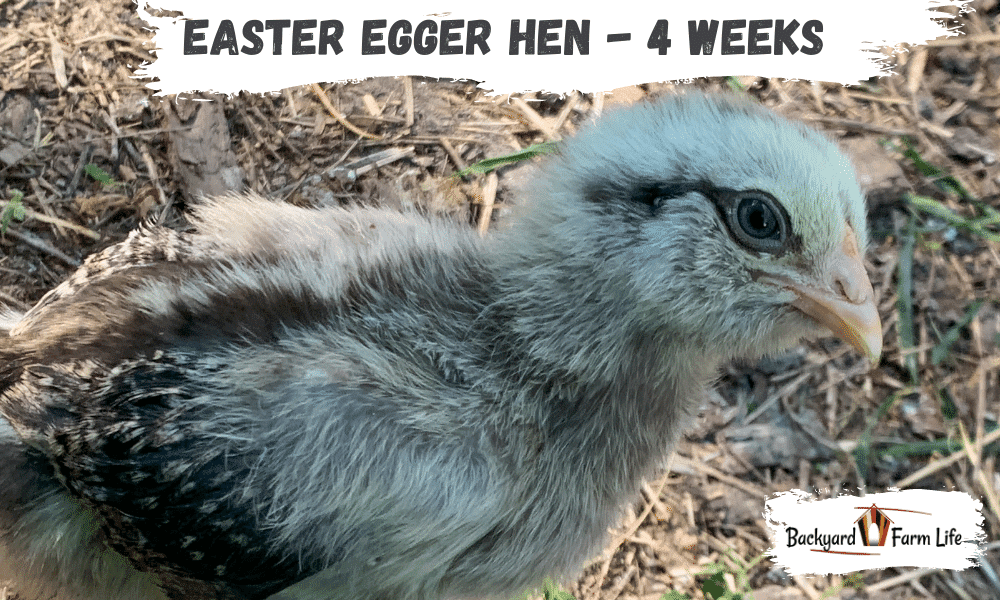
From 0-4 weeks old, there is very little in the way of telling whether you’ve got Easter Egger males or females.
Neither the males nor females will display combs or wattles, and they’ll be pretty much the same size.
Unless you’re a professional and can examine their vents and wings carefully, all you’ve got going for you is your instinct.
Easter Egger Cockerel VS. Pullet (From 6-12 Weeks)
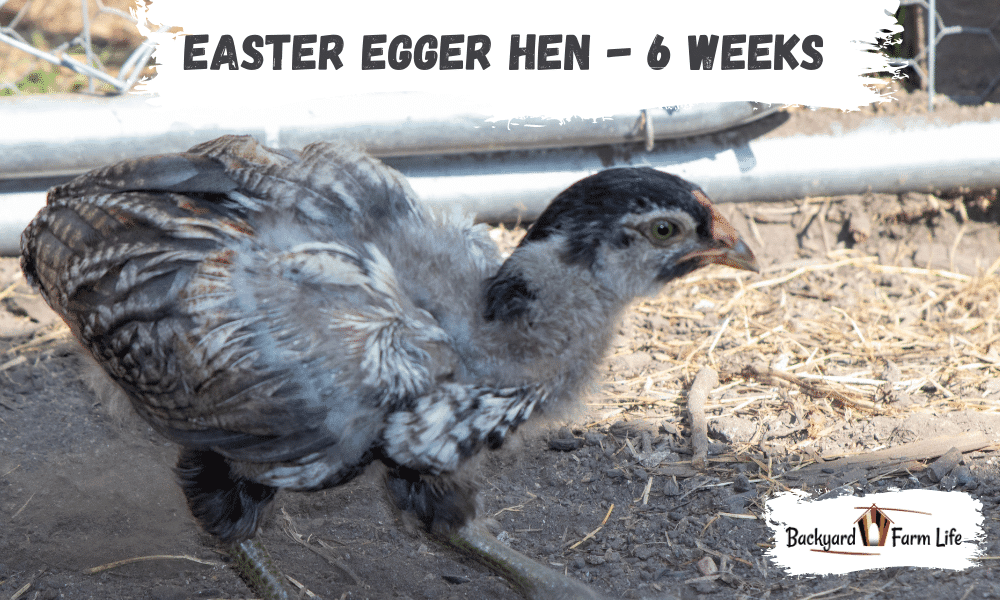
From 6-12 weeks old, your Easter Egger cockerels (young males) and pullets (young females) will start showing more obvious signs of their gender.
This is because from about 6-12 weeks old your Easter Egger males will normally start showing small wattles and pea-sized combs on their forehead. At this age, Easter Egger hens will not show their wattles and combs. This comes much later in hens.
Of course, this timeframe will also depend on what this Easter Egger has been crossbred with!
Lastly, although it’s not fool-proof, females are more likely to be all one color, whereas males will develop a different color of neck & hackle feathers.
Easter Egger 12 Weeks Old Male Vs. Female
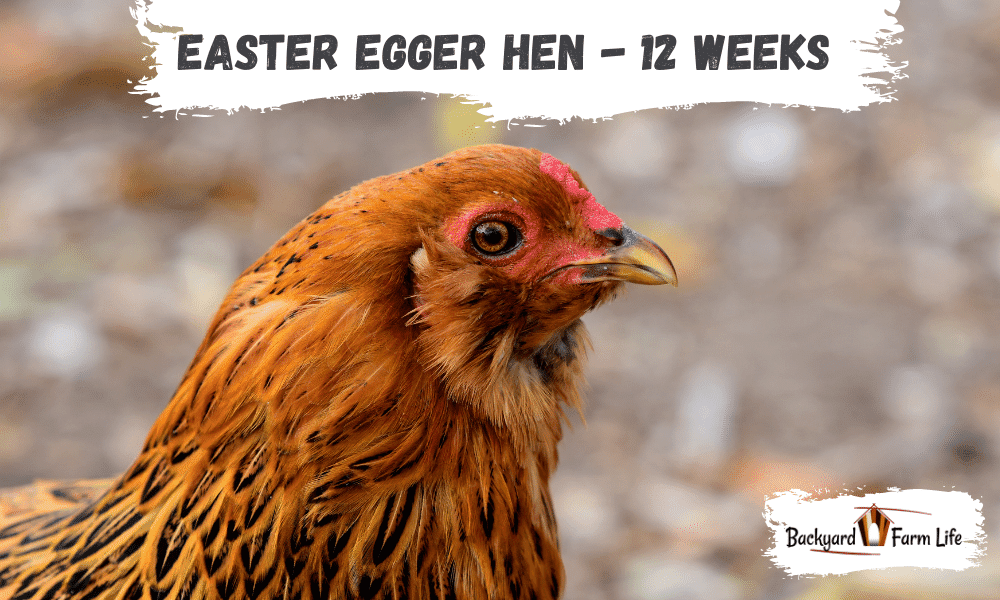
If you haven’t managed to pinpoint which of your Easter Egger baby chicks are male or female by now, you certainly will from 12-to 16 weeks old.
This is because by then your cockerel Easter Eggers will be showing their wattles and combs, be starting to look a bit bigger than the pullets and they will be more controlling, and they may start to crow.
By now, your Easter Egger female still shouldn’t show their wattles and combs (or if they do they will be insignificant compared to that of a male). They will begin to look a bit smaller than the males and stand less upright.
You should also see a more pronounced beard and hackle feathers on the males more so than on females!
In Conclusion
So, because of the commonalities of Easter Eggers, usually being crossbred from Ameraucanas or Araucanas, you can use this to help you differentiate between the roosters and the hens.
From as young as 6-10 weeks cockerels will begin to show wattles and combs. At this age, Easter Egger pullets won’t have any wattles or combs!
From any older, you can look at their hackle feathers, their overall size, and their behaviors as well.
All of these subtitle signs can be used to piece together whether you’ve got male or female Easter Egger baby chicks.
If you’re still not sure what you’ve got, feel free to comment below or on our Facebook page with your pictures and I’ll be happy to take a look!
Happy backyard farming.
